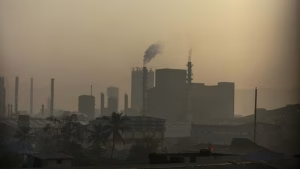GS3 – Environment

Context
Although industries are among the top contributors to air pollution, they receive less than 1% of total funding under the National Clean Air Programme (NCAP) and Finance Commission grants, indicating the need for NCAP 2.0 to prioritise industrial emissions control.
National Clean Air Programme (NCAP)
- Launched by: Ministry of Environment, Forest and Climate Change (MoEFCC) in 2019.
- Objective: Improve air quality in non-attainment and Million Plus cities.
- Target: Reduce PM2.5 and PM10 levels by 20–30% by 2024, using 2017 as the baseline.
- Revision: PM10 reduction targets increased to up to 40%.
Major Sources of Industrial Pollution
- Industrial Proximity: 37% of India’s most polluted cities are located near large-scale polluting industries.
- Brick Kilns: Over 1.4 lakh units, mostly using outdated and polluting technology.
- Unregulated MSMEs: Heavy dependence on fossil fuels such as coal and furnace oil.
- Enforcement Gaps: Many peri-urban industries lie outside the scope of urban local body regulation.
Impact of Industrial Emissions
- Public Health: Contributed to 1.67 million deaths in India (Lancet Commission).
- Water Pollution: Over 70% of Yamuna River pollution is industrial in origin (CPCB).
- Agricultural Damage: Near thermal plants, crop yields fall by 10–30% (ICAR).
- Economic Loss: Air pollution reduces GDP by 8.5% annually due to health and productivity losses.
- Climate Change: Industries account for over 25% of India’s CO₂ emissions.
Implementation Challenges in NCAP
- Limited Funding: Only 0.6% of NCAP funds are directed toward industrial pollution control.
- Outdated Technology: Legacy brick kilns and small factories lack clean tech upgrades.
- Poor Enforcement: Non-compliance with CPCB dust norms in stone crushing and similar sectors.
- Transparency Issues: Industries are not mandated to publicly report emission levels.
Way Forward – NCAP 2.0 Recommendations
- Dedicated Industrial Focus: Allocate specific funds for industrial emission reduction.
- Enforce Clean Tech Adoption: Mandate use of zigzag kilns, wet scrubbers, etc., which reduce PM emissions by over 70%.
- Mandatory Emission Reporting: Link emission transparency to consent-to-operate approvals.
- Airshed-Level Coordination: Enhance cooperation among SPCBs, ULBs, and central ministries for regional planning.
- Green Transition Support: Offer subsidies and grants to MSMEs for shifting to clean energy sources.




